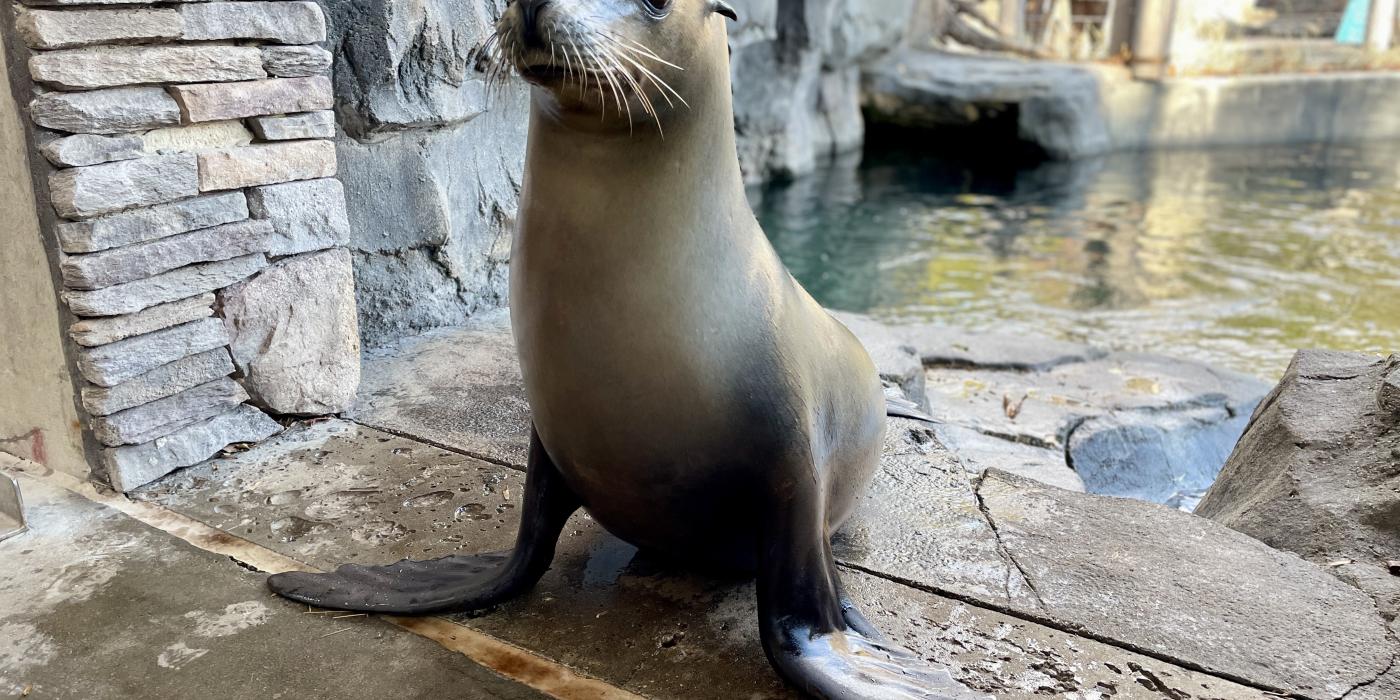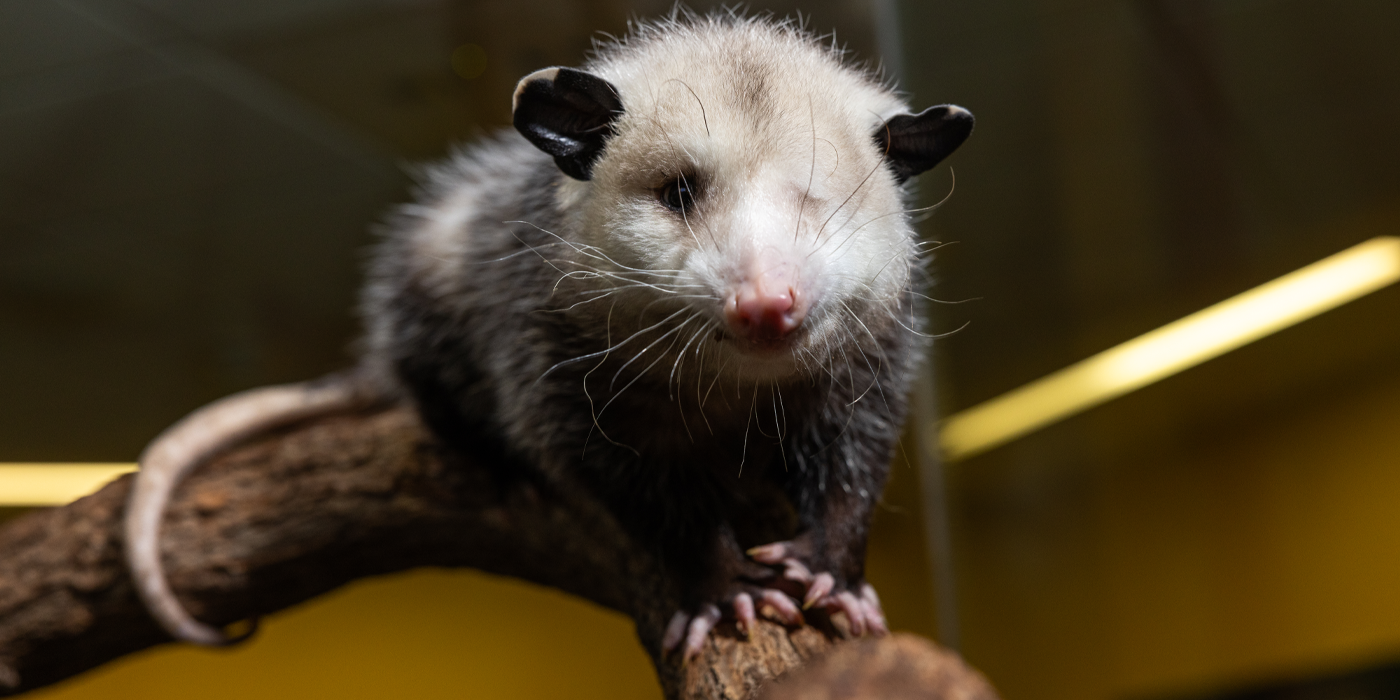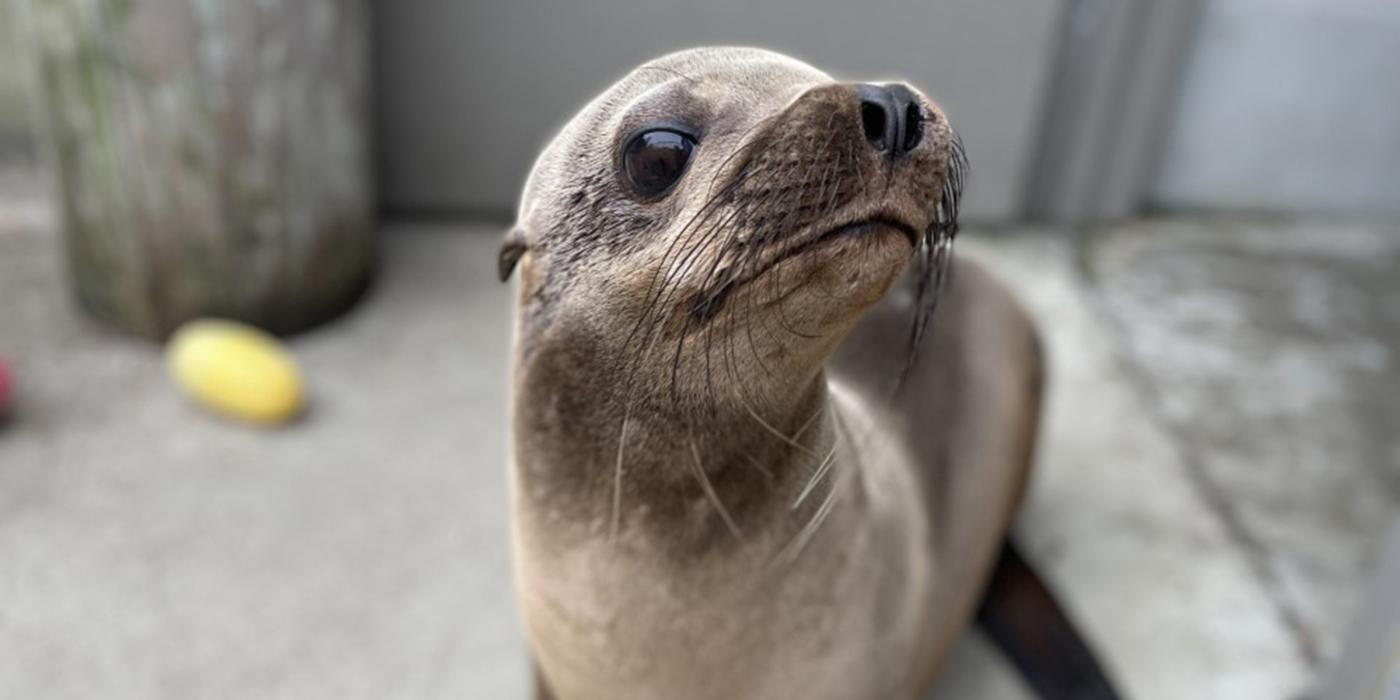New at the Zoo: Meet Our Gray Seal, Jo-Jo
A brave and curious gray seal pup is making a splash on American Trail! One-year-old female Jo-Jo was rescued from the wild and made her debut at the Smithsonian’s National Zoo and Conservation Biology Institute in January. Get to know Jo-Jo’s personality and learn more about her second chance at life from assistant curator Rebecca Sturniolo.
What are your favorite facts about gray seals?
Some visitors will bark at the gray seals, mistaking them for their loud and gregarious cousins, the California sea lions. Gray seals sound quite different from sea lions—they whistle, moan, woo and expel air loudly through their nostrils.
Another favorite fact of mine is that these marine mammals are amazing divers and have been recorded at depths up to 1,500 feet! They use their sensitive vibrissae (whiskers) to help navigate underwater.
How did Jo-Jo come to live at the Zoo?
JoJo was born in the wild and found about three hours away from here on Ventnor Beach, New Jersey, with injuries to her neck and jaw. She was rescued by the Marine Mammal Stranding Center. Staff there discovered that cataracts in Jo-Jo’s eyes greatly reduced her ability to see; she seems to be able to only sense shadows and movement.
Her impairment made it difficult for her to catch fish, and rescue staff deemed her non-releasable. Luckily, our team has experience and expertise in working with pinnipeds who are visually impaired. We took her under our care Sept. 16, and she is doing very well! It is wonderful that we could offer Jo-Jo a second chance at life as an ambassador for her species.
The Smithsonian’s National Zoo and Conservation Biology Institute is one of just 10 institutions that house gray seals in the United States. It’s a pretty unique and special experience to see these animals up close. I hope that when visitors meet her, they will take pride in the work we are doing.
How do you tell Jo-Jo apart from the other seals?
She’s the smallest, but she is also still a juvenile and won't be fully grown until about 5 years of age. Jo-Jo only weighs about 130 pounds (60 kilograms), and our next smallest seal is about 220 pounds (100 kilograms). She’s about a quarter the size of our male, Gunther! Her fur is very mottled with spots as well.
What is Jo-Jo’s personality like?
The Zoo was a very unfamiliar environment for Jo-Jo, what with all the new sounds, smells, keepers and seals to meet. Jo-Jo has a bold personality and is not one to shy away. When we introduced her to the other members of our colony, she was usually the first to make contact.
She is also very smart and quickly learned to associate her feedings with the sound of a rattle. That said, she has a stubborn streak. If she’s not in the mood to participate in a training session or eat, no amount of calling or coaxing will get her out of the water!
What do gray seals eat? Does Jo-Jo have a favorite food?
Wild gray seals are opportunistic feeders and feed mostly on fish. They will also eat squid, octopuses, crustaceans, and may eat the occasional seabird if the opportunity arises. At the Zoo, we feed a variety of fish including capelin, mackerel, butterfish and herring. We also feed squid.
When Jo-Jo first arrived, she wouldn’t come over to take fish but kept to mostly one area of our holding pools. To build her confidence and strengthen our relationship, we would toss fish to her in the pool and let her eat them off the bottom while we quietly waited at the edge, saying the word “fish” each time we tossed them to her. She quickly learned to pair that word with food.
Within a few days, she came over to us at the edge of the pool and took fish from our hands, which was very exciting! A couple of weeks went by before she came out of the pool and over to us for feedings. Jo-Jo seems to like herring and mackerel the best. It took her a while to get used to squid and butterfish.
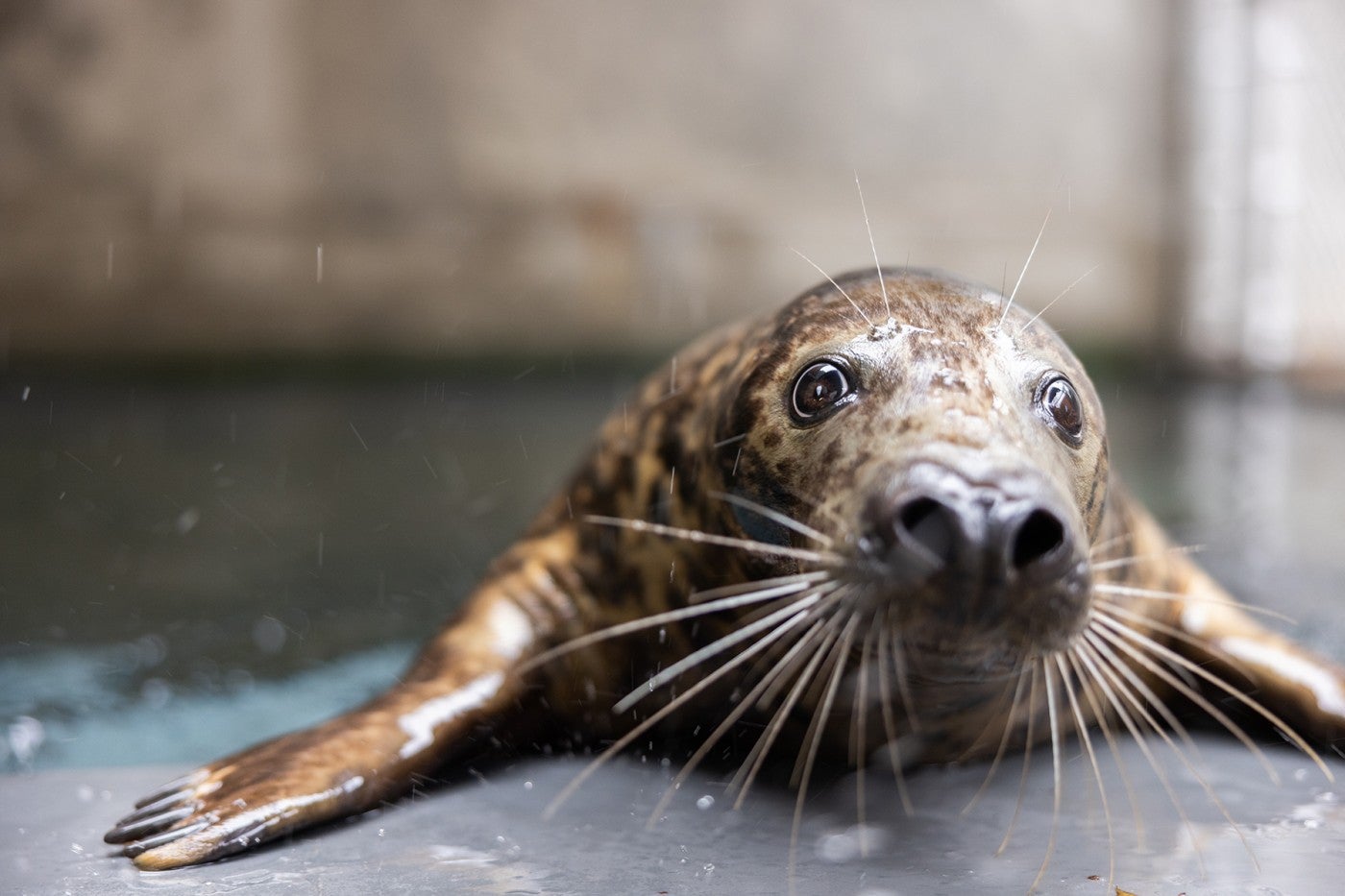
How do you adjust your training methods for an animal that is visually impaired?
Setting our animals up for success is always a priority we strive for, but with Jo-Jo we go the extra mile, recognizing she can’t see obstacles in her habitat or other animals or keepers. Because of her impaired sight, we’ve been taking everything slowly and working in small approximations.
We first started training Jo-Jo by using a target—a buoy on the end of a dowel—and placed beads inside so that it makes a rattling sound. She has learned to associate that sound with the keeper who is feeding her and will follow the target around.
When training Jo-Jo, we make sure our cues are loud and clear to avoid confusion when other animals are being fed. She is the only seal that has a specific sound that we use to call her over and engage her in training sessions, ensuring she goes to the right keeper for feeding and doesn’t interfere with another seal’s training sessions.
With a sighted seal, we might ask them to go further distances, knowing they would be able to see everything around them. With Jo-Jo, we take smaller steps to build her confidence moving around areas of the habitat where she may not be so familiar. Participation in training sessions is always voluntary, but the animals receive a favorite food as a reward when they do. For Jo-Jo, that’s fish!
What husbandry training behaviors is she learning?
Jo-Jo is learning to recognize her name and the word “fish.” We will say “fish” when handing her food so that she can anticipate what is coming towards her face since she can’t see very well. She may be a candidate for cataract surgery, so one of the husbandry behaviors we will focus on is training Jo-Jo to receive eye drops.
Like the rest of our seals, we will train her for voluntary blood draws, vaccinations, radiographs, ultrasounds, body and mouth checks and moving around her exhibit. With time, we will start training her using tactile cues, much like we use with our older seals who are also visually impaired.
How did you introduce Jo-Jo to the other seals in the colony?
We took things slow and introduced her to our calmest animals first, Kara and Kjya. We introduced one seal at a time and started by housing Jo-Jo and another seal next door to each other with only a “howdy” gate separating their pools. The seals could hear, smell each other and touch noses through the fence if they wanted to.
The next step was to open up the door slightly while feeding them. If sessions went well, we increased the door openings and moved the seals closer together.
Our goal was to always keep the interactions positive and to ensure that we could separate the seals if necessary. Thankfully, we never had to intervene. Within a few sessions, we could put both seals together in the same pool.
Jo-Jo was much more curious about the other seals than they were with her, but was never aggressive or pushy – should would nose them on their sides as a form of greeting and then would return her attention to the keeper who was feeding her.
Jo-Jo has successfully been introduced to all of our gray seals and now all five of them are sharing their three pools together.
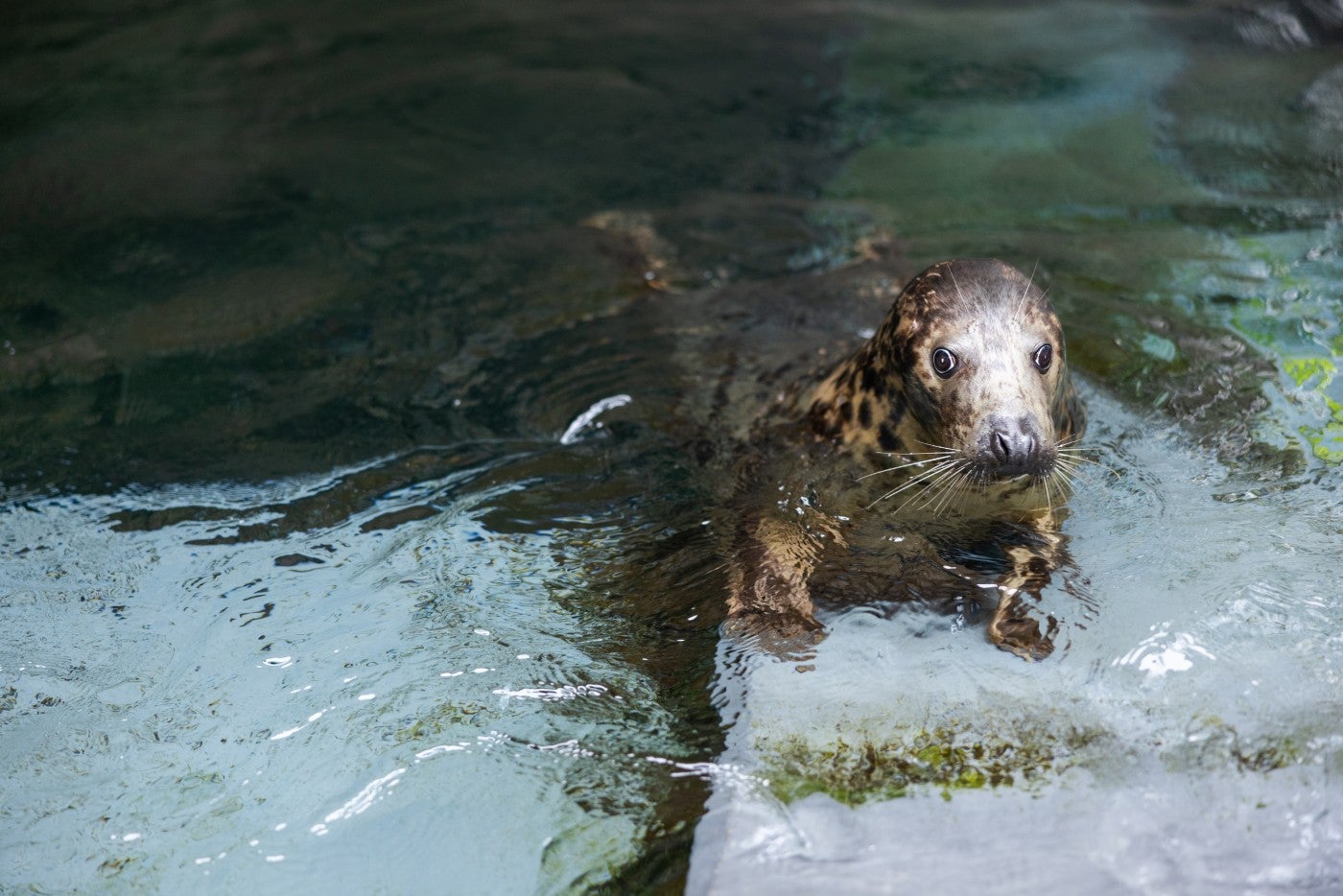
What are you looking forward to most about working with Jo-Jo?
I’m excited to see how she assimilates into our colony. Jo-Jo doesn’t have the same experience being around people as our others seals, who were all born in zoos. It will be fun to see how much she learns and to watch her confidence grow during training and feeding sessions.
I want to help gray seals! What can I do?
Like many animals that call the ocean home, gray seals face many threats, including pollution, overfishing and injuries from vessels and people. Abandoned nets and fishing lines can entangle seals or their prey.
We can help gray seals and all ocean creatures by reducing our use of single-use plastics. Each year, up to 12 million metric tons of plastic pollution end up in the ocean. Plastic does not decompose; rather, it is reduced to smaller pieces—called microplastics—which have been found in the bellies of marine animals. What’s more, certain types of plastic can release chemicals and other toxins into the environment.
Protect gray seals and their habitats by opting for reusable water bottles, grocery bags, utensils and straws. We can all do our part to keep beaches and oceans clean.
Got any tips for spotting Jo-Jo on exhibit?
The best time to spot Jo-Jo is during feeding demonstrations. We typically feed our seals around 9 a.m., 11 a.m. and 2 p.m. As Jo-Jo becomes more confident and comfortable with her habitat, it is likely she will choose to spend the majority of her day in the exhibit pool. We hope you stop by and see her during your next visit to American Trail!
This story appears in the February 2023 issue of National Zoo News. Did you know there’s another new face on American Trail? Meet our inquisitive ‘foodie’—a female bad eagle named Acadia—in this Q+A with keepers Ashley Graham and Sam Milne.
Related Species:

